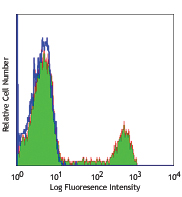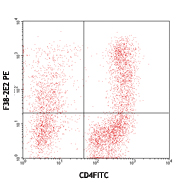- Clone
- 24F.10C12 (See other available formats)
- Regulatory Status
- RUO
- Other Names
- B7-DC, PD-L2, PDL2, B7DC
- Isotype
- Mouse IgG2a, κ
- Ave. Rating
- Submit a Review
- Product Citations
- publications

-

Human monocyte-derived dendritic cells were stained with anti-human CD273 (clone 24F.10C12) Purified (filled histogram) or mouse IgG2a, κ Purified isotype control (open histogram), followed by biotinylated mouse IgG and SAV-PE.
| Cat # | Size | Price | Quantity Check Availability | Save | ||
|---|---|---|---|---|---|---|
| 329602 | 100 µg | 90€ | ||||
CD273, known as B7-DC, is also called programmed death ligand 2 (PDL2). This ligand is a 25 kD type I transmembrane protein and a member of B7 family within the immunoglobulin receptor superfamily and is expressed on a subset of dendritic cells, liver and a small subset of macrophages as well as a few transformed cell lines. CD273 has been reported to be stimulatory on dendritic cells when cross-linked and to inhibit T cell activation upon engaging the PD-1 receptor. CD273 has also been reported to bind to an alternative receptor and to mediate T cell activation through such non-PD1 mediated interactions.
Product DetailsProduct Details
- Reactivity
- Human
- Antibody Type
- Monoclonal
- Host Species
- Mouse
- Immunogen
- Human PD-L2 cDNA
- Formulation
- Phosphate-buffered solution, pH 7.2, containing 0.09% sodium azide.
- Preparation
- The antibody was purified by affinity chromatography.
- Concentration
- 0.5 mg/ml
- Storage & Handling
- The antibody solution should be stored undiluted between 2°C and 8°C.
- Application
-
FC - Quality tested
IHC-F, FA - Reported in the literature, not verified in house - Recommended Usage
-
Each lot of this antibody is quality control tested by immunofluorescent staining with flow cytometric analysis. For flow cytometric staining, the suggested use of this reagent is ≤ 1.0 µg per 106 cells in 100 µl volume or 100 µl of whole blood.
- Application References
-
- Brown JA, et al. 2003. J. Immunol. 170:1257
- Rodig N, et al. 2003. Eur. J. Immunol. 33:3117
- Product Citations
- RRID
-
AB_1089010 (BioLegend Cat. No. 329602)
Antigen Details
- Structure
- B7 Immunoglobulin superfamily, 25 kD
- Distribution
-
Dendritic cells, liver, few transformed cell lines, subset of macrophages
- Function
- Binds to PD-1 and alternative receptor; ligation on DC stimulates, inhibits T cell responses via PD-1 binding, stimulates T cells via alternative receptor binding and promotes tumor immunity
- Ligand/Receptor
- PD-1
- Cell Type
- Dendritic cells, Macrophages
- Biology Area
- Costimulatory Molecules, Immunology
- Molecular Family
- CD Molecules, Immune Checkpoint Receptors
- Antigen References
-
1. Shin T, et al. 2003. J. Exp. Med. 198:31.
2. Liu X, et al. 2003. J. Exp. Med. 197:1721.
3. Carreno BM, et al. 2002. Annu. Rev. Immunol. 20:29. - Gene ID
- 80380 View all products for this Gene ID
- UniProt
- View information about CD273 on UniProt.org
Customers Also Purchased


Compare Data Across All Formats
This data display is provided for general comparisons between formats.
Your actual data may vary due to variations in samples, target cells, instruments and their settings, staining conditions, and other factors.
If you need assistance with selecting the best format contact our expert technical support team.
 Login / Register
Login / Register 










Follow Us